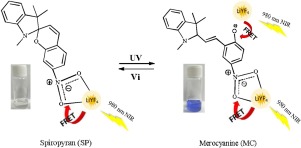Journal of Photochemistry and Photobiology A: Chemistry ( IF 4.1 ) Pub Date : 2020-01-20 , DOI: 10.1016/j.jphotochem.2019.112303 Hsiu-Wen Chien , Chien-Hsin Yang , Min-Ting Tsai , Tzong-Liu Wang

|
In this study, two photoswitchable spiropryran-capped hybrid nanoparticles based on two different core/shell upconverting nanoparticles (UCNPs) were reported. Two kinds of LiYF4 core/shell UCNPs doped with Yb3+/Ho3+ and Yb3+/Tm3+ were first prepared and could emit the ultraviolet (UV) and visible light under 980 nm NIR excitation respectively. X-ray diffraction (XRD) and transmission electron microscope (TEM) analysis indicated that both kinds of UCNPs had the tetragonal phase and the single-crystal structure. The photoluminescence (PL) intensities were much enhanced through the active-core/active-shell synthetic strategy. Next, the spiropyran molecules could be coordinated onto the surface of the oleate-capped UCNPs via ligand exchange, which was confirmed by fourier transform infrared (FTIR) spectra. PL spectra for the Ho3+-doped SP-UCNPs hybrid nanoparticles revealed that the green emission band excited by near-infrared (NIR) light could be completely quenched after illuminating SP-UCNPs with UV for 150 s. The cyclical photoswitching tests were further carried out for both kinds of UCNPs by alternating irradiation with UV/visible, UV/NIR, or NIR/visible light. The optical switching of PL intensity of the spiropryran-capped UCPNs did not have apparent decline effect after 10 cycles of on/off test. A reversible photoswitching of the hybrid nanoparticles revealed that both kinds of spiropyran-capped UCNPs had a superior photostability for the biological applications.
中文翻译:

基于紫外发射和双发射上转换纳米晶体的光开关螺吡喃帽杂化纳米粒子用于生物成像
在这项研究中,报道了基于两种不同的核/壳上转换纳米颗粒(UCNP)的两种光可转换螺并吡喃帽封端的杂化纳米颗粒。两种掺有Yb 3+ / Ho 3+和Yb 3+ / Tm 3+的LiYF 4核/壳UCNP首先制备了它们,它们可以分别在980 nm NIR激发下发射紫外线(UV)和可见光。X射线衍射(XRD)和透射电子显微镜(TEM)分析表明,两种UCNP均具有四方相和单晶结构。通过主动核心/主动壳合成策略大大提高了光致发光(PL)强度。接下来,螺吡喃分子可以通过配体交换配位到油酸酯封端的UCNPs表面,这通过傅立叶变换红外(FTIR)光谱得以证实。Ho 3+的PL光谱掺杂SP-UCNPs杂化纳米颗粒表明,用UV照射SP-UCNPs 150 s后,近红外(NIR)激发的绿色发射带可以完全淬灭。通过用紫外线/可见光,紫外线/近红外或近红外/可见光交替照射,进一步对两种UCNP进行了周期性光开关测试。在开/关测试10个循环后,螺吡喃帽式UCPN的PL强度的光开关没有明显的下降效果。杂化纳米颗粒的可逆光开关显示,两种螺吡喃帽封端的UCNP在生物学应用中均具有优异的光稳定性。











































 京公网安备 11010802027423号
京公网安备 11010802027423号